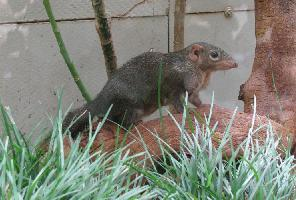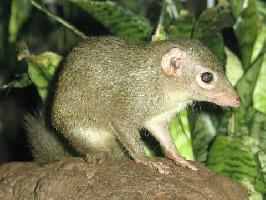
Greutăți și măsuri
| Lungime | de la 12,5 la 18 cm |
|---|---|
| Greutate | de la 100 la 150 g |
| Lungimea cozii | de la 14,5 la 17,5 cm |
Date biologice
| Durata de viață | False |
|---|---|
| Durata gestației | de la 45 la 55 d |
| Numărul de pui | 1 - 2 |
Descrierea animalului
The Northern Treeshrew (Tupaia belangeri) is a small, intriguing mammal that inhabits the dense forests and thick underbrush of Southeast Asia, ranging from India and China through to Vietnam and Thailand. This species is part of the family Tupaiidae, which bridges a fascinating gap in the evolutionary tree between insectivores and primates, offering valuable insights into mammalian evolution.Typically, the Northern Treeshrew has a slender body measuring about 18 to 22 centimeters in length, with a tail almost equaling its body length, adding another 16 to 20 centimeters. The tail, unlike those of many other small mammals, is not bushy but rather thinly covered with hair, which aids in balance rather than warmth. The fur of the Northern Treeshrew is generally a brownish color, with variations from dark brown to grayish or reddish hues, often with a lighter underbelly. This coloring provides excellent camouflage against the forest floor, an essential adaptation for avoiding predators.
One of the most distinctive features of the Northern Treeshrew is its sharp, pointed snout, which is much elongated and gives the animal an almost shrew-like appearance. This snout is a critical tool for foraging, as it allows the treeshrew to sniff out and extract insects, spiders, and other small invertebrates from the leaf litter and crevices of tree bark. In addition to these, the Northern Treeshrew's diet is surprisingly varied, including fruits, seeds, and occasionally small vertebrates, making it an opportunistic omnivore.
The eyes of the Northern Treeshrew are another point of interest. Positioned forward on the head, they provide the animal with excellent binocular vision, which is crucial for navigating the complex three-dimensional environment of the forest canopy and underbrush. Despite this, the treeshrew's vision is not its primary sense – smell and hearing are highly developed and play a significant role in detecting predators and locating food.
Socially, the Northern Treeshrew exhibits a range of behaviors from solitary to somewhat social. They are territorial animals, with males particularly showing aggression towards other males to defend their territory. Communication among treeshrews involves a combination of scent marking, vocalizations, and body postures.
Reproduction in the Northern Treeshrew occurs throughout the year, with females capable of giving birth to multiple litters annually. After a gestation period of about 45-50 days, a litter of one to three young is born. The offspring are altricial, meaning they are born in a relatively undeveloped state and require considerable care from the mother. The young treeshrews grow rapidly, however, and are weaned within a month, reaching sexual maturity at around three months of age.
Despite their wide range and apparent abundance, Northern Treeshrews face threats from habitat destruction due to logging, agricultural expansion, and urbanization. Additionally, they are sometimes hunted for food or captured for the pet trade. However, they are currently listed as Least Concern by the International Union for Conservation of Nature (IUCN), indicating that they are not currently considered at risk of extinction.
In conclusion, the Northern Treeshrew is a fascinating and adaptable mammal with unique characteristics that reflect its evolutionary position. Its presence in diverse habitats across Southeast Asia underscores the importance of forest conservation efforts in the region to preserve the biodiversity and ecological dynamics of these complex ecosystems.
Animale similare
Fotografii noi cu animale
Top 10 animale
- Dolphin gull (Leucophaeus scoresbii)
- Diana monkey (Cercopithecus diana)
- Moustached guenon (Cercopithecus cephus)
- Galápagos tortoise (Geochelone nigra complex)
- Russian tortoise (Testudo horsfieldii)
- Stone loach (Barbatula barbatula)
- Japanese macaque (Macaca fuscata)
- Greek tortoise (Testudo graeca)
- Common flying dragon (Draco volans)
- Vendace (Coregonus albula)
